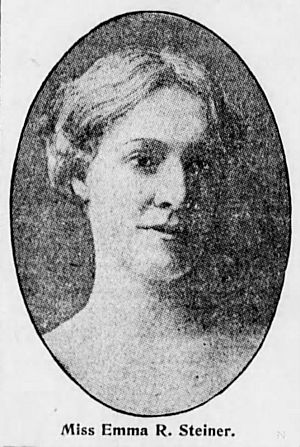Emma Roberto Steiner facts for kids
Emma Roberta Steiner (born 1856, died 1929) was an amazing American musician. She wrote music and led orchestras. She was one of the very first women in the U.S. to earn money by leading music groups. She conducted over 6,000 shows! She was also the first woman to lead a theater orchestra in New York City.
Her career lasted almost 50 years, starting in the 1870s. She led many touring comic opera groups until she passed away in 1929. In the early 1900s, she took a break from music for about ten years. She moved to Alaska and became a prospector, searching for valuable minerals. Emma wrote hundreds of musical pieces, including seven operas (which are like plays set to music).
Quick facts for kids
Emma Roberto Steiner
|
|
|---|---|
 |
|
| Born | 1852 Baltimore |
| Occupation | Composer, conductor |
Contents
Early Life and Music
Emma Steiner was born in Baltimore, Maryland, in 1856. Her father, Colonel Frederick Steiner, was a hero from the Mexican War. Her mother was a very good piano player. Because of this, Emma grew up surrounded by music.
She started writing songs when she was just 7 years old. By age 9, she had composed a piano duet. People noticed her talent early on. They even suggested her father send her to Paris to study music. However, her parents did not want her to pursue music as a career. But Emma kept composing anyway. When she was 11, she started writing an opera called Aminaide. One part of it was even performed at the Peabody Conservatory, a famous music school in Baltimore. Emma herself was not able to attend this school.
Starting a Career
Music historians are not sure exactly how or when, but by age 21, Emma had left her family. She moved to Chicago to follow her dream of becoming a professional musician. In Chicago, she became an assistant music director for the Rice and Collier Opera Company. This company was run by E. E. Rice, a well-known American musical-theater composer.
There are different stories about how she got her start. Some say she was noticed for her beautiful singing. Others say her light music caught attention. Still others point to E. E. Rice, who hired her even though she was a woman. In the years that followed, she worked as a conductor for many touring opera companies. These groups performed popular comic operas, including those by Gilbert and Sullivan.
In 1889 and again in 1891, her opera Fleurette was performed and received good reviews. Emma became even more famous when one of her songs was played at the 1893 World's Columbian Exhibition in Chicago. The next year, she led a performance of her own music in New York City. This show was put on by the respected Anton Seidl Orchestra. Emma said this was her proudest moment in her career so far.
Challenges and New Adventures
Even after getting sick with pneumonia in 1896, Emma kept conducting, composing, and performing. She worked for many important people in music. One of them was Heinrich Conried, who directed the Metropolitan Opera. From 1903 to 1908, he thought about letting her conduct at the Met. But he decided against it because she was a woman. This was a very bold idea for the early 1900s.
Emma kept improving her musical skills. She started her own company, the Emma R. Steiner Gaiety Opera Company. This was one of the first and only opera companies in America led by a woman. It also supported other women in music. However, by 1900, her eyesight started getting worse due to an illness. It also became harder to find money to produce her operas. Despite these problems, she kept writing music. She created the operas The Man From Paris in 1900 and The Burra Pundit in 1907 or 1908.
To keep writing and producing her operas, Emma decided to go to Nome, Alaska. She went there to search for gold. In Alaska, she became a traveler and a prospector in the tin mining areas near Nome. She was highly respected because she found important tin deposits. She then studied mineralogy and metallurgy at Columbia University. These subjects helped her understand minerals and metals.
Later Career and Legacy
After almost ten years, Emma returned from Alaska. She became a strong supporter of Alaska, often giving talks about the state and its history. Later, she went back to music. She continued writing and performing into the 1920s.
The Metropolitan Opera held a special performance of her works in 1925. This was the last time a woman would conduct there until 1976! Emma also helped create a home for older and sick musicians. She gave the money from some of her later concerts to support this home. When she passed away on February 27, 1929, The New York Times newspaper wrote about her. They said the stress of running the home might have caused her health to fail.
Lasting Impact
During her career, Emma Steiner conducted more than 6,000 performances. Some people even say it was 7,000! These shows included operas, operettas, and many of her own musical pieces. She wrote hundreds of musical works, including seven full operas.
Emma Steiner, along with Caroline B. Nichols, is remembered as one of the first women in the United States to have a successful career as a music conductor.
Works
Operettas
- 1877: Fleurette
- 1894: Day Dream (based on Alfred Tennyson's "Sleeping Beauty")
- 1894: Brigands
- 1894: La belle Marguerite
- 1900: The man from Paris
- 1907/8: Burra Pundit
- The little Hussar
- The Viking
- The Sleeping Beauty
- The Alchemist
- A flower divinely fair
Orchestral Music
- The Flag – Forever May It Wave


